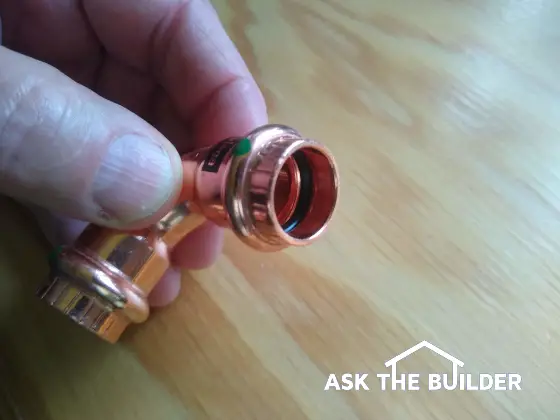Building Technology – First in a Series

This looks like an ordinary 1/2-inch copper 90 bend for a water supply line. It’s got cutting-edge technology inside! (C) Copyright 2020 Tim Carter
This is the first column in a series where I’d like to share with you how technology improvements have helped improve building products. That said, not all improvements have worked out so well and sometimes it takes several permutations until the manufacturers get it right.
It’s important to realize I’ve been blessed to have worked in the residential construction industry for decades. This span of time gives me a unique perspective on new products. Another key point is that early in my career, I spent years taking apart 100-year-old houses and was able to see how the craftsmen of old built. Some of their methods, in my opinion, are far better than the way things are done today. I’ll share much of that with you in this series that will unfold as the year progresses.
Today, I’d like to dive into plumbing as it’s an area in many homes that causes lots of consternation with consumers like you because repairs can be costly. You’d probably not think that you could change much when it comes to simple pipes and fixtures, but you’d be wrong. The sad thing is there’s not enough space in this column to tell you about everything.
Let’s start with simple advancements in both drainage and water-supply piping. Go back in time and plumbers used cast iron, galvanized iron, and copper for drain lines. In rare instances, they’d have to use a lead pipe to make certain drains work. The old cast iron was susceptible to leaks and cracks because of how it was made. Galvanized iron pipes would corrode and start to choke off with deposits causing clogs.
Today’s cast iron is spun cast and has a uniform wall thickness. You create leak-proof joints in seconds with rubber gaskets and stainless-steel band clamps. It’s the perfect material to use for vertical stacks in your home to prevent noise caused by water cascading down large-diameter vertical pipes.
The entire plastics industry exploded in the 1960s and codes permitted plastic drain pipes. Plastic drain lines perform quite well and I’ve installed miles of this pipe. Not too long ago it experienced another technology jump when it was made lighter than the first-generation plastic. You can purchase foam-core plastic drain pipe now.
Water supply lines many years ago were made using galvanized iron. These would suffer from corrosion and choke off too. Copper became the standard but once again, plastic muscled its way into the marketplace.
Imagine installing plastic water lines in a new home that have no joints or fittings. It’s installed much like an electric cable. That’s what I just did at my daughter’s new home. The only joints are in the mechanical room at a distribution manifold and the shut-off valve under a sink or where the pipe connects to a shower or tub valve.
I installed all of the water supply lines to four bathrooms, a kitchen and five outdoor hose bibs in less than four hours. Using traditional copper with hundreds of fittings I might have gotten part of one bathroom done in that same amount of time.
Copper water lines have also seen tremendous technological advancements. In a recent column, I shared with you the new fittings that require no solder. You can create a leak-proof joint in less than five seconds using fittings that contain a rubber o-ring. You can’t imagine how much time these save. The best part is you never have to wonder if a soldered joint will leak!
Accessory plumbing products have also seen big changes. For years the plumbing vent pipe flashing up on your roof has been made with a standard rubber that gets destroyed by the sun’s ultraviolet rays in just a few years and then starts to leak. You can now buy a vent-pipe flashing that has a superior siliconized rubber boot that might not be destroyed by the sun for five, or more, decades.
Water supply lines that connect sink faucets, toilet tanks, and washing machines to the water supply have seen amazing changes. Not too awful long ago plumbers had to carefully bend soft copper tubes to make connections. Washing machines used old rubber hoses. Now you as a DIYr can use flexible hoses protected by braided stainless-steel wire to make leak-proof connections in seconds!
Faucet manufacturers continue to make improvements with the cartridges that control the water flow when you turn a handle. I clearly remember years ago having to change rubber washers inside faucets to stop drips. It used to take some skill to change a washer to stop a faucet leak. Now you can stop faucet drips without calling a plumber. With the plethora of how-to videos on the Internet, you can switch out a faucet cartridge faster than you might read this column.
My advice to you if using a brand-new product is to read the installation instructions and be sure everything is being done correctly. Also, keep in mind that the first generation of some new products might not have all the bugs worked out. If you’re installing a product that’s going to be hidden behind walls or under slabs, think about waiting several years so you don’t become a statistic. Go with proven technology in these situations.
Column 1335